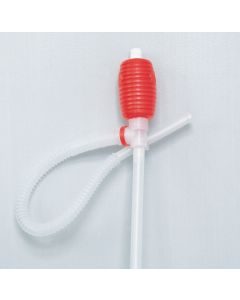 A bulb siphon pump is a simple, yet essential, piece of equipment in practically any workplace. It uses simple physics and vacuum power to quickly and efficiently siphon liquid from one container to another without spilling a drop.
A bulb siphon pump is a simple, yet essential, piece of equipment in practically any workplace. It uses simple physics and vacuum power to quickly and efficiently siphon liquid from one container to another without spilling a drop.
Perhaps the biggest benefit of having a bulb siphon pump is that the user doesn’t have to get the siphon started by sucking on one end of the tube. Anybody who has ended up with a mouthful of gasoline while siphoning gas from a car can attest to the benefits of that!
Instead, the vacuum pressure is created by the bulb rather than your lungs. So the transfer of liquid is safer and more efficient.
How Bulb Siphon Pumps Work
There aren’t a lot of parts to a bulb siphon pump. Basically, it’s just a tube with a pliable bulb in the middle. It’s used to siphon liquid from one tank into a receiving receptacle, such as a gas can. As long as the receiving receptacle is lower than the original tank, siphoning the liquid is fast and easy.
When you put one end of the tube in the tank you want to siphon and the other end in the receptacle you want to siphon into, transferring the liquid is simple. All you do is put your finger over the receiving end of the tube, squeeze the siphon bulb a couple of times to create vacuum pressure, and then let go when the liquid starts to flow. Gravity and air pressure will do the rest.
Safety First
Probably the most common liquid used with a bulb siphon pump is gasoline. Removing gas from a stalled or broken vehicle so that it can be used somewhere else is something many operations do every day. But bulb siphon pumps can also be used to remove standing water after flooding, to drain oil or grease pooled at the bottom of machinery, or to move practically any other type of liquid quickly, efficiently, and without any mess.
Common sense and simple safety rules are all that’s needed when using a bulb siphon pump. Be careful not to use a bulb siphon pump with materials that are highly caustic, such as strong acids. It’s also a good idea not to siphon any liquid when you don’t know what it is. Strong chemicals such as bleaches or ammonia-based chemicals could corrode the plastic of the tube and create a hazardous materials spill.
Whenever handling flammable materials such as gasoline, always use caution. Keep fire or sparks away when siphoning. And don’t smoke anywhere near a siphoning operation.
Bulb siphon pumps are simple, yet effective, tools that can make any siphoning operation simple, quick, and safe.
